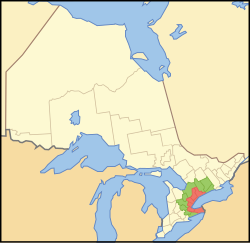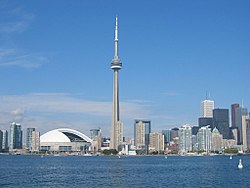Golden Horseshoe
This article needs additional citations for verification. (September 2009) |
The Golden Horseshoe | |
|---|---|
 Location of the Golden Horseshoe in Ontario. ██ Core area ██ Extended area | |
| Country | |
| Province | |
| Area | |
| • Total | 31,561.57 km2 (12,185.99 sq mi) |
| • Extended area | 21,464.12 km2 (8,287.34 sq mi) |
| • Core area | 10,097.45 km2 (3,898.65 sq mi) |
| Population (2006) | |
| • Total | 8,102,163 |
| • Density | 256.7/km2 (665/sq mi) |
| • Extended area | 1,614,101 |
| • Core area | 6,488,062 |
| Time zone | UTC−5 (EST) |
| • Summer (DST) | UTC−4 (EDT) |
| Postal code prefixes | |
| Area code(s) | 226, 289, 416, 519, 647, 705, 905 |




The Golden Horseshoe is a densely populated and industrialized region centred around the Greater Toronto Area at the western end of Lake Ontario in Southern Ontario, Canada, with outer boundaries stretching south to Lake Erie and north to Georgian Bay. Most of it is also part of the Quebec City – Windsor Corridor and the Great Lakes Megalopolis. With a population of 6.5 million people, it makes up slightly over 19% of the population of Canada and contains approximately 49% of Ontario's population,[1] making it one of the largest population concentrations in North America. Although it is a geographically named sub-region of Southern Ontario, the Greater Golden Horseshoe is also used today to describe the metropolitan region that stretches across the area in totality including smaller centres outside of the core region.
The core of the region starts from Niagara Falls at the eastern end of the Niagara Peninsula and extends west, wrapping around the western end of Lake Ontario at Hamilton and then turning northeast to its anchor city Toronto (on the northwestern shore of Lake Ontario), before finally terminating at Oshawa, just east of Toronto. The wider region spreads inland in all directions away from the Lake Ontario shoreline, southwest to Brantford, west to the Kitchener-Waterloo area, north to Barrie, and northeast to Peterborough. The whole region's area covers approximately 33,500 km2 (13,000 sq mi), out of this, 7,300 km2 (2,800 sq mi) is covered by the Greenbelt.
The phrase, "Golden Horseshoe," was first used by Westinghouse president Herbert H. Rogge in a speech to the Hamilton Chamber of Commerce, on January 12, 1954:
Hamilton in 50 years will be the forward cleat in a 'golden horseshoe' of industrial development from Oshawa to the Niagara River...150 miles long and 50 miles (80 km) wide...It will run from Niagara Falls on the south to about Oshawa on the north and take in numerous cities and towns already there, including Hamilton and Toronto.
— [2]
The speech writer who actually penned the phrase was Charles Hunter MacBain, executive assistant to five Westinghouse presidents including Rogge.[citation needed]
Definition
Golden Horseshoe was used as a geographical distinction since the 1950s, but it was only on July 13, 2004 that a report from the provincial Ministry of Public Infrastructure Renewal entitled Places to Grow coined the term Greater Golden Horseshoe, extending the boundaries west to Waterloo Region, north to Barrie, and northeast to Peterborough.[3] A subsequent edition released February 16, 2005, broadened the term further, adding Brant, Haldimand and Northumberland Counties. Statistics Canada defined the region first in its 2001 census as the Extended Golden Horseshoe, combining many Census Metropolitan Areas. The Greater Golden Horseshoe is officially designated in Ontario Regulation 416/905[4] under the Places to Grow Act.
Demographics
The population of the Greater Golden Horseshoe is 8.1 million residents as of the 2006 census.[1]
The region is projected to grow to 11.5 million people by 2031.[5] The definition of the Golden Horseshoe as an agglomerated urban area, that is combining Census Metropolitan Areas is similar to how population counts are tabulated for Combined Statistical Area which are used in the United States to combine more than one metropolitan area, defined as an MSA (Metropolitan Statistical Area), into a larger overall urbanized area. These metropolitan areas are intrinsically linked through inter-dependence of services, trade, transportation corridors, close proximity and other factors, in this context they can also be viewed as a single region. In terms of population, the Greater Horseshoe is the 6th most populous greater urbanized area in North America, just behind the Baltimore-Washington-Northern Virginia CSA.[when?]
Economy
The economy of this region is very diverse. The Toronto Stock Exchange is the third largest in North America by market capitalization (after the New York Stock Exchange and NASDAQ), and seventh largest in the world.[6] Recently, five major office-dominated skyscrapers have been planned in its financial district (to go along with hundreds of condominiums).
Notably, Toronto is the world headquarters for nine Fortune 500 companies, ranking it among the most powerful cities in the world economically.
Niagara Falls has one of the world's largest per-capita tourist economies, benefiting from millions of tourists coming to see its majestic waterfalls and shop in its numerous stores. The wine making and fruit growing industries of the Niagara Peninsula produce award-winning wines which are beginning to attract attention around the world, in particular the ice wine for which the region is known.
Cities such as Hamilton, Oshawa, Oakville, Whitby and Kitchener all contain major large-scale industrial production facilities, Hamilton being steel-dominated and Oshawa being much more car-oriented. Other significant automotive-production facilities also exist in Brampton, St. Catharines, Cambridge and Alliston. Hamilton and Toronto also have two of the largest seaports in Lake Ontario. The Welland Canal system handles tanker ship and recreational traffic through the Great Lakes. Large rail and truck distribution facilities are located in Toronto, Vaughan and Brampton. As of 2008, however, the manufacturing sector of this region has begun to experience a significant decline in as a result of unfavourable currency exchange rates, high energy costs, and reduced demand from the United States.
Name
The "horseshoe" part of the region's name is derived from the characteristic horseshoe shape of the west end of Lake Ontario with Burlington roughly positioned in the centre. The "golden" part is historically attributed to the region's wealth and prosperity, according to the Canadian Oxford Dictionary.
Attractions
Toronto is a world city, known for its performing arts and night life. Downtown Toronto is one of the largest downtowns in North America. The city is pedestrian friendly and has one of the lowest crime rates in Canada.[7]
Toronto's Yorkville is an example of a world-class shopping district in the city. The city also is home to several notable shopping malls such as Yorkdale, The Eaton Centre and Sherway Gardens. Located in the suburbs of Toronto are Vaughan Mills and Square One Shopping Centre in Mississauga, the largest suburban shopping mall in Ontario.
Large annual cultural festivals that draw tourists and local alike include Oktoberfest in Kitchener and the Scotiabank Caribbean Carnival (formerly known as Caribana) in Toronto. Toronto Pride Week culminates in the Gay Pride parade, which is one of the largest in the world.
The Niagara Region has become one of the major wine-production areas in Canada. The Golden Horseshoe contains many small towns with tourist-jammed, historic main streets, most notably the community of Niagara-on-the-Lake, located at the mouth of the Niagara River. Niagara Falls is one of the world's largest waterfalls, and attracts millions to Clifton Hill, a neighbourhood featuring hundreds of souvenir stores, restaurants and skyline-changing hotels. Casinos here are also a huge draw.
The Niagara Escarpment, a world biosphere as designated by the United Nations, runs north and then east through the region cutting the Niagara Gorge at Niagara Falls. The Bruce Trail runs along the escarpment through mostly protected woodlands. Similar protection of some wooded areas exists on the Oak Ridges Moraine running west-east in the north end of the Greater Toronto Area, although development pressures continue to threaten habitat.
Hamilton has the historical reputation of being a blue-collar city; however, waterfront redevelopments and large-scale gentrification have been rapidly changing the perception of the city, although it retains a dominant industrial base. Barrie and Peterborough are situated close to scenic lakes, rivers and hills in the northern reaches of the Golden Horseshoe, where all-year around recreation contributes to the local economies, in addition to being major service centres.
Education


The Golden Horseshoe is home to several universities, many of which are well known and respected throughout the world, including the University of Toronto and McMaster University, which are ranked 1st and 4th in Canada respectively by the Academic Ranking of World Universities. Other universities in the region include Brock University, University of Guelph, University of Waterloo, Wilfrid Laurier University, Trent University, York University, OCAD University, Georgian College, University of Ontario Institute of Technology, and Ryerson University.
There is also a strong integration between the universities and hospitals in the area, particularly in Toronto and Hamilton, which have an extensive medical research core.
Transportation
The Golden Horseshoe is served by an extensive network of expressways, the backbone of which is Highway 401, one of the widest and busiest expressways in the world. Regional transit is provided by GO Transit trains and buses, and by private bus operators Greyhound and Coach Canada. Local transit is provided by municipal agencies, the largest of which is the Toronto Transit Commission, which operates four rapid transit lines and an extensive bus and streetcar network.
The primary airport of the region is Toronto Pearson International Airport (also known as Lester B. Pearson International Airport), located in Mississauga, which is the busiest in Canada, handling approximately 32.3 million passengers in 2008, and offering non-stop flights worldwide. Other regional airports of significance include John C. Munro Hamilton International Airport south of Hamilton, which is a major regional freight and courier location; Buttonville Airport and Billy Bishop Toronto City Airport in the Greater Toronto Area, both of which mostly serve regional business travellers but the latter being the third largest in the region for passenger volume; and Region of Waterloo International Airport just east of Kitchener, serving the Region of Waterloo. On the U.S. side, Buffalo Niagara International Airport is second largest in passenger volume in the region to Pearson Airport, serving 5.5 million passengers in 2008 and is frequently used by Canadian passengers flying to American destinations.
Divisions
Census Metropolitan Areas
CMAs in the Greater Golden Horseshoe with over 100,000 in population:[9]
Golden Horseshoe
|
Greater Golden Horseshoe
|
Municipalities
|
References
- ^ a b "Portrait of the Canadian Population in 2006: Subprovincial population dynamics, Greater Golden Horseshoe". Statistics Canada, 2006 Census of Population. 2007-03-13. Retrieved 2007-03-13.
- ^ "Fast Facts from Hamilton's Past". Retrieved 2007-01-08.
- ^ "Places to Grow". Archived from the original on 2006-09-07. Retrieved 2006-09-13.
- ^ Ontario Statutes and Regulations
- ^ Greater Golden Horseshoe, GTA and Hamilton Population, Household and Employment Forecasts
- ^ 2 Ontario
- ^ Toronto 26th most dangerous city in Canada: report, CTV News, March 13, 2008
- ^ "McMaster University Website". Retrieved 2007-06-26.
- ^ "Population and dwelling counts, for census metropolitan areas and census agglomerations, 2006 and 2001 censuses - 100% data". Statistics Canada. 2007-03-13. Retrieved 2007-03-13.
